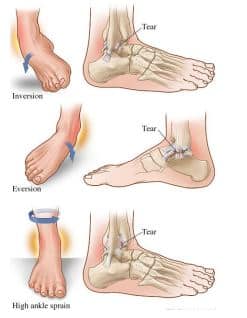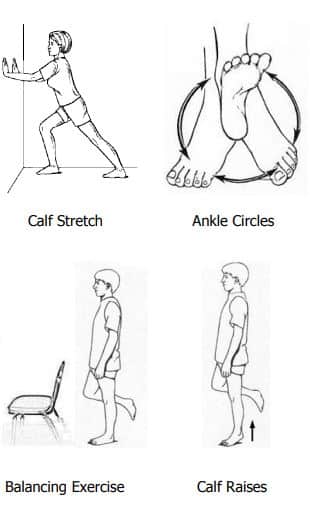
The ankle is one of the most common parts of the body to be sprained. If you land incorrectly on your foot, this can cause the ankle to roll. Rolling can stretch or tear ligaments within the ankle which creates the sprain. If you have had an ankle sprain in the past, you may be more likely to sprain your ankle again.
Your doctor diagnoses an ankle sprain based on symptoms, clinical examination, and x-rays. X-rays may be ordered by your doctor to confirm the diagnosis of a sprain or to exclude other problems.
The symptoms may vary depending on the severity of the ligament damages, but usually include:

There are three kinds of ankle sprains that are based on where the tear in the ligament is located. There are inversion sprains (located on the outside of the foot), exersion sprains (located on the inside of the foot), and high ankle sprains (located at the top of the foot).
Treatment options for ankle sprains include anti-inflammatory medication, applying ice to the ankle, refraining from physical activities, bracing, and physical therapy. There are rarely any complications and symptoms generally resolve over time.
Taking anti-inflammatory medicine or NSAIDS (non-steroidal anti-inflammatory drugs) such as Motrin, Advil, Naproxen or Aleve as directed by your doctor may be helpful.
This medication should be taken on a schedule for 10 to 14 days to allow the medicine to build to therapeutic levels in the body. Taking the medication infrequently allows the medicine levels to drop, which decreases its effectiveness.
Ice packs or ice massage can be applied to the ankle immediately after the injury for 15 minutes. This can be repeated every 30-45 minutes several times a day.
Ice massage is performed by filling several paper cups with water and placing them in a freezer. When frozen, the cup’s rim is torn off to create a ice cone. The ice is then directly applied to the sore area until the area becomes numb.

Symptoms may be relieved by avoiding activities that cause the pain.
Stay off your ankle as much as possible. Crutches may be used.
Ice the ankle for 15 minutes at a time. Rest and remove the icepack for 30-45 minutes, then repeat. Continue icing for 3 days. The ice will help reduce swelling.
Another way to reduce the swelling and prevent further injuries is to keep the joint stable by wrapping it with an elastic ace bandage or having it splinted. This can be done by the Primary Care Physician, Emergency Room, or Walk-in Clinic.
Keep your ankle raised above your heart when you sit or lie down.

If your child have sprained an ankle, the chances of another sprain in the future increases. To prevent this, your child should start performing ankle exercises after 2-3 weeks.
These stretching exercises will help prevent ankle sprains. Stretching should be performed in sets of 10 two times per day. Hold each stretch for 10 seconds.